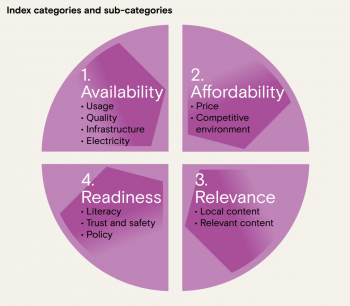
Photo credit: Electronic Frontier Foundation/CC BY-2.0.
Despite growing mobile subscribers, India has the world’s largest offline population – 865 million – followed by China (661 million) and Indonesia (207 million), notes a new report.
India ranks 36 out of 75 countries in a ranking of internet inclusivity.
Singapore ties for top with Sweden, with its Wireless@SG program hailed as contributing to the city-state being “a standard bearer of public-access wifi.” Among Asian countries, Nepal fares the worst, ranking 56th.
The gender gap in internet access is still widening
Especially in low-income countries, women remain, overwhelmingly, offline. “In the average low-income country in the Index, 94 percent of the female population is offline, and 41 percent does not even have access to a mobile phone,” the report observes.
The Inclusive Internet Index (PDF), released yesterday by the Economic Intelligence Unit, was commissioned by Facebook’s Internet.org. Mark Zuckerberg’s “free” internet program has proved controversial; critics have accused it of being a thinly-veiled, net neutrality-violating “Facebook for all” scheme.
As of 2016, the divide in connectivity is also increasing: the internet usage rate among women is 12 percent lower than that among men. In 2013, that gap stood at 11 percent.
A “yawning gap” exists across poorer and richer countries, the report adds: “Virtually the entire bottom half of the table in female internet access is populated by lower-middle-income and low-income countries.”
See: Facebook has a big ‘women problem’ in India
Connectivity isn’t everything
While basic infrastructure – such as electricity and broadband – accounts for much of the divide, relevant web content – think Indian-language articles or local-language government services – is another key factor. On this measure, India again falls in the middle – at 36 out of the 75 countries ranked.
See: India now has 462 million internet users – 79% of traffic is mobile
The report’s “relevance” measure focuses on how useful content is, and flags programs by developing countries including India for placing government services online, as well as localized content providers such as ShareChat.
But neither, apparently, is income
Predictably, most of the rankings are topped by countries with higher incomes. But Malaysia tops the “readiness” measure – which reflects the capacity of users to take advantage of being online. Several low- and middle-income countries – including Romania, Brazil, and Nepal – have used a mix of policy (such as a national e-inclusion strategy, which Nepal has) and digital literacy to boost inclusion, the report notes.
Meanwhile, costs of internet access remain a key hurdle. A 500MB prepaid plan eats up an average 15 percent of per-capita income in less-developed countries, according to an affordability study cited by the report.
Method

Photo credit: The Inclusive Internet Index.
The overall rankings reflect Internet.org’s priority on access: “A country’s availability score has the greater impact on its overall index ranking than the other categories.” The 75 countries chosen reflect the “economies we thought were most interesting from a connectivity perspective,” says the report.
See: India bans Facebook’s ‘free’ wifi scheme
This post The digital divide is widening – especially for women appeared first on Tech in Asia.